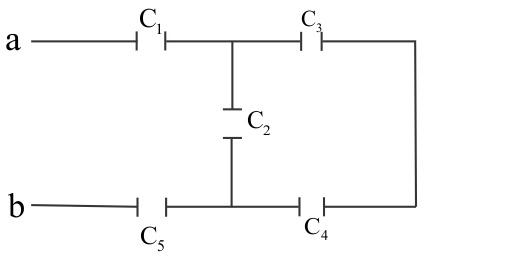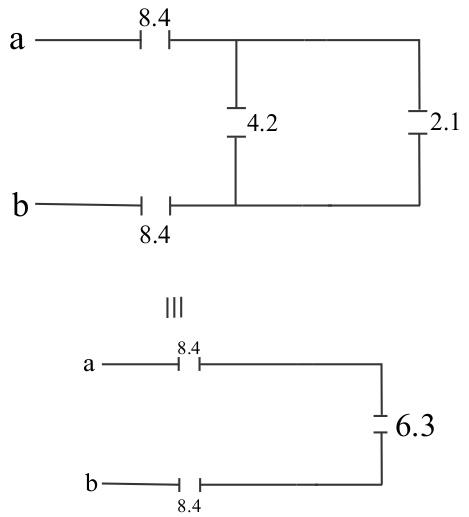
- In the figure, ${C_1} = {C_5} = 8.4\mu F$ and ${C_2} = {C_3} = {C_4} = 4.2\mu F$. The applied potential is ${V_{ab}} = 220V$. The equivalent capacitance of the network between points $a$ and $b$ is $C$. Calculate the value of $2C$.

Answer
141.3k+ views
Hint: The equivalent capacitance in the circuit when capacitors are parallel to each other is calculated by –
${C_{eq}} = {C_1} + {C_2} + \ldots {C_n}$
And the equivalent capacitance in the circuit when capacitors are in series with each other is calculated by –
\[\dfrac{1}{{{C_{eq}}}} = \dfrac{1}{{{C_1}}} + \dfrac{1}{{{C_2}}} + \ldots + \dfrac{1}{{{C_n}}}\]
where, $n$ is the number capacitors.
Then, find the equivalent capacitance and multiply it by $2$.
Complete step by step solution:
The circuit which has two or more electrical devices connected with it, then, there are many other ways by which we can connect them. They can either be series or parallel.
The circuit is said to be in series when two components in the circuit have a common node and the current which flows through all the components in the circuit is the same. In these types of circuits, there is only one path for the current. When the capacitors are connected in series, the equivalent capacitance is less than any one of the series capacitor’s individual response. The equivalent capacitance in series can be calculated by –
\[\dfrac{1}{{{C_{eq}}}} = \dfrac{1}{{{C_1}}} + \dfrac{1}{{{C_2}}} + \ldots + \dfrac{1}{{{C_n}}}\]
The circuit is said to be parallel when there are multiple paths for the current to flow. In this type of circuit, all components have the same voltage across all ends. The equivalent capacitance in parallel can be calculated by –
${C_{eq}} = {C_1} + {C_2} + \ldots {C_n}$
Now, according to the question, it is given that –
${C_1} = {C_5} = 8.4\mu F$
${C_2} = {C_3} = {C_4} = 4.2\mu F$
${V_{ab}} = 220V$
Now, the equivalent capacitance between ${C_3}$ and ${C_4}$ are in series, so the equivalent capacitance is –
$\dfrac{1}{{{C_{34}}}} = \dfrac{1}{{{C_3}}} + \dfrac{1}{{{C_4}}}$
Putting the values in above formula –
$
\dfrac{1}{{{C_{34}}}} = \dfrac{1}{{4.2}} + \dfrac{1}{{4.2}} \\
\dfrac{1}{{{C_{34}}}} = \dfrac{2}{{4.2}} \\
{C_{34}} = 2.1\mu F \\
$
So, the circuit can be drawn as –

The capacitors $4.2$ and $2.1$ are parallel to each other so, the equivalent capacitance is –
$
{C_{234}} = 4.2 + 2.1 \\
{C_{234}} = 6.3\mu F \\
$

Now, the equivalent capacitance can be calculated by –
$\dfrac{1}{{{C_{eq}}}} = \dfrac{1}{{3.4}} + \dfrac{1}{{8.4}} + \dfrac{1}{{6.3}}$
By further solving, we get –
${C_{eq}} = 2.52\mu F$
To calculate $2C$ we have to multiply the equivalent capacitance by $2$, we get –
$2{C_{eq}} = 2 \times 2.52 = 5.04\mu F$
Hence, the value of $2C$ in the circuit is $5.04\mu F$.
Note: When the capacitors are connected in series, the equivalent capacitance is less than any one of the series capacitor’s individual response. When the capacitors are in parallel with each other, then, the overall effect is that of a single equivalent capacitor having the sum total of the plate areas of the individual capacitors.
${C_{eq}} = {C_1} + {C_2} + \ldots {C_n}$
And the equivalent capacitance in the circuit when capacitors are in series with each other is calculated by –
\[\dfrac{1}{{{C_{eq}}}} = \dfrac{1}{{{C_1}}} + \dfrac{1}{{{C_2}}} + \ldots + \dfrac{1}{{{C_n}}}\]
where, $n$ is the number capacitors.
Then, find the equivalent capacitance and multiply it by $2$.
Complete step by step solution:
The circuit which has two or more electrical devices connected with it, then, there are many other ways by which we can connect them. They can either be series or parallel.
The circuit is said to be in series when two components in the circuit have a common node and the current which flows through all the components in the circuit is the same. In these types of circuits, there is only one path for the current. When the capacitors are connected in series, the equivalent capacitance is less than any one of the series capacitor’s individual response. The equivalent capacitance in series can be calculated by –
\[\dfrac{1}{{{C_{eq}}}} = \dfrac{1}{{{C_1}}} + \dfrac{1}{{{C_2}}} + \ldots + \dfrac{1}{{{C_n}}}\]
The circuit is said to be parallel when there are multiple paths for the current to flow. In this type of circuit, all components have the same voltage across all ends. The equivalent capacitance in parallel can be calculated by –
${C_{eq}} = {C_1} + {C_2} + \ldots {C_n}$
Now, according to the question, it is given that –
${C_1} = {C_5} = 8.4\mu F$
${C_2} = {C_3} = {C_4} = 4.2\mu F$
${V_{ab}} = 220V$
Now, the equivalent capacitance between ${C_3}$ and ${C_4}$ are in series, so the equivalent capacitance is –
$\dfrac{1}{{{C_{34}}}} = \dfrac{1}{{{C_3}}} + \dfrac{1}{{{C_4}}}$
Putting the values in above formula –
$
\dfrac{1}{{{C_{34}}}} = \dfrac{1}{{4.2}} + \dfrac{1}{{4.2}} \\
\dfrac{1}{{{C_{34}}}} = \dfrac{2}{{4.2}} \\
{C_{34}} = 2.1\mu F \\
$
So, the circuit can be drawn as –

The capacitors $4.2$ and $2.1$ are parallel to each other so, the equivalent capacitance is –
$
{C_{234}} = 4.2 + 2.1 \\
{C_{234}} = 6.3\mu F \\
$

Now, the equivalent capacitance can be calculated by –
$\dfrac{1}{{{C_{eq}}}} = \dfrac{1}{{3.4}} + \dfrac{1}{{8.4}} + \dfrac{1}{{6.3}}$
By further solving, we get –
${C_{eq}} = 2.52\mu F$
To calculate $2C$ we have to multiply the equivalent capacitance by $2$, we get –
$2{C_{eq}} = 2 \times 2.52 = 5.04\mu F$
Hence, the value of $2C$ in the circuit is $5.04\mu F$.
Note: When the capacitors are connected in series, the equivalent capacitance is less than any one of the series capacitor’s individual response. When the capacitors are in parallel with each other, then, the overall effect is that of a single equivalent capacitor having the sum total of the plate areas of the individual capacitors.
Recently Updated Pages
Young's Double Slit Experiment Step by Step Derivation

Difference Between Circuit Switching and Packet Switching

Difference Between Mass and Weight

JEE Main Participating Colleges 2024 - A Complete List of Top Colleges

JEE Main Maths Paper Pattern 2025 – Marking, Sections & Tips

Sign up for JEE Main 2025 Live Classes - Vedantu

Trending doubts
JEE Main 2025 Session 2: Application Form (Out), Exam Dates (Released), Eligibility, & More

JEE Main Exam Marking Scheme: Detailed Breakdown of Marks and Negative Marking

JEE Main 2025: Derivation of Equation of Trajectory in Physics

Electric Field Due to Uniformly Charged Ring for JEE Main 2025 - Formula and Derivation

Learn About Angle Of Deviation In Prism: JEE Main Physics 2025

Electric field due to uniformly charged sphere class 12 physics JEE_Main

Other Pages
JEE Advanced Marks vs Ranks 2025: Understanding Category-wise Qualifying Marks and Previous Year Cut-offs

JEE Advanced Weightage 2025 Chapter-Wise for Physics, Maths and Chemistry

Degree of Dissociation and Its Formula With Solved Example for JEE

JEE Main 2025: Conversion of Galvanometer Into Ammeter And Voltmeter in Physics

Dual Nature of Radiation and Matter Class 12 Notes: CBSE Physics Chapter 11

Formula for number of images formed by two plane mirrors class 12 physics JEE_Main




